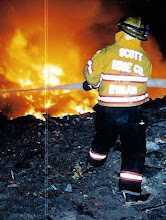The
engine company pulls up in front of the single story house, the siren winding
down. Grey black smoke oozes from
previously unknown cracks and windows, doors, and the building eaves. The firefighter in the rear dismounts and
reaches for the nozzle and hose stacked in the horizontal bed or cross lay and
pulls it onto his shoulder. The officer,
axe and halligan bar, the “irons” in his hand, pulls the hose from the second
stack as the firefighter advances toward the front door. The driver comes around the engine and
relieves the officer at this so he can follow the firefighter.
At the front door, the officer
wrenches open the screen, disabling it so it won’t close on them while the
firefighter flakes out the remaining hose from his shoulder to ensure smooth
entry to the building without kinks or catches.
Dropping the nozzle, he takes the axe from the officer who jams the pry
end of the halligan into the wood frame by the lock in the door. With one good whack, the door pops open and
smoke pours from around it.
Pulling the door shut again, the
officer and firefighter drop to their knees and drop their helmets to the
ground, putting on breathing apparatus face pieces and protective hoods in a
well-practiced motion. Hood, helmet, and
gloves in place, the firefighter picks up the nozzle, the hose now hard with
water, and pushes the fractured front door open again. With a well-trained crew, the process takes
place without the exchange of a word; poetry in motion.
The firefighter and officer enter
the blackness of the house, their eyes widening to the physical limits,
attempting to see the fire. Their senses
go into overdrive, adrenaline having a romp through their bodies. Both listen for the crackling of flames and
feeling heat through their protective clothing, trying to discern the direction
from which it emanates. Windows shatter
as fellow arriving firefighters begin to ventilate the building, hoping to
allow heat and smoke to escape; making conditions better for the attack
crew—and any victims who might remain.
A few feet further in, the nozzleman
spies a glow in front of him through the viscous smoke; just a fleeting glance,
but it gives him a direction to head.
“It’s straight ahead,” he yells, his
voice muffled by the face piece along with the hissing of the inhalation and
exhalation from his and the officer’s mask.
Their conversations are now short, but more frequent, punctuated by
expletives. They drag and pull the hose
another yard or so to the kitchen doorway where the fire is now more visible,
starting to roll over their heads into the living room. This is not the made for television fire with
the perfect visibility of gas jets (sorry Chicago Fire). Here the flames remain muted by the smoke,
the heat pushing the attack team into the floor.
The firefighter opens the nozzle,
directing the fist thick straight stream of water at the ceiling, whipping it
in circles. The water makes a staccato
thumping bass drum against the plaster, but without rhythm. . The firefighter and officer push into the
room and the angle of the hose stream drops as the nozzleman hits flames at
cabinet level throughout the room.
Visibility, if anything, is worse as the water converts the fire to
steam and the heat and smoke and ceiling level drop, the plume inverted by the
water application. Other firefighters
spread into the house, searching for victims or the spread of the fire beyond
the kitchen.
The bulk of the fire now out in the
kitchen, another firefighter with a pike pole, a long stick with a hook at the
end, pushes past the nozzleman and thrusts the pike into the ceiling. Pulling down the plaster, the space above,
and any remaining fire, is visible for the nozzleman to hit with his
stream. The smoke and heat begin to
lift, exiting through the broken kitchen windows, leaving a smother wet jungle
in the room. A few more minutes of work
and it becomes clear the bulk of the fire is out.
The firefighter and officer are
relieved by others and head outside for a break. Kneeling again on the front lawn, they remove
their helmets and face pieces and open their bunker coats. In the cool fall air, steam rises from their
uncovered heads and bodies, condensing from the sweat.
They smile and converse about this
easy fire as the adrenaline surging through their systems begins to
recede. A satisfaction is left having
completed what they regularly trained for, going against the beast or the “Red
Devil” as it is sometimes described.
It’s an untenable environment after just a few minutes without the right
equipment and one that few want to visit much less work in. That increases the satisfaction; doing
something only a small percentage of people can do, going “inside.”






















